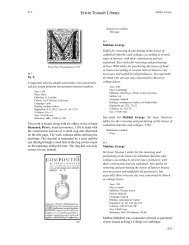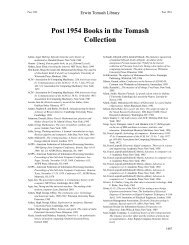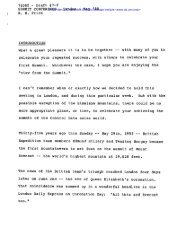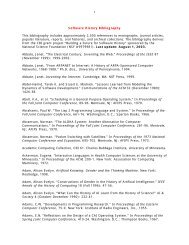B chapter.indd - Charles Babbage Institute - University of Minnesota
B chapter.indd - Charles Babbage Institute - University of Minnesota
B chapter.indd - Charles Babbage Institute - University of Minnesota
Create successful ePaper yourself
Turn your PDF publications into a flip-book with our unique Google optimized e-Paper software.
Erwin Tomash Library<br />
Bianchini, Giovanni Bianchini, Giovanni<br />
Pagination: pp. [12], 268, [38]<br />
Collation: )( 4 2)( 2 A–2K 4 L 2 2A–2D 4 2E 3<br />
Size: 191x151 mm<br />
Reference: Pogg Vol. I, p. 183<br />
This is a Latin version <strong>of</strong> the work described above.<br />
While the works are similar, containing the same woodcut<br />
diagrams and tables, the examples <strong>of</strong> calculations <strong>of</strong>ten<br />
differ, and the accuracy <strong>of</strong> the tables suffers from the<br />
same problem as in the German version. See comments<br />
in Beyer, Johann Hartmann; Ein newe und schone Art<br />
der Vollkommenen Visier-Kunst, 1603.<br />
Illustrations available:<br />
Title page<br />
B 150<br />
Bianchini, Giovanni (ca.1410–1469)<br />
Tabulae celestium motuum eorumque canones.<br />
Year: 1460–1470<br />
Place: Italy<br />
Edition: manuscript<br />
Language: Latin<br />
Figures: Manuscript tables in red and black<br />
Binding: contemporary vellum over boards<br />
Pagination: ff. [b], [1], [2b], [16], 1–122, [2b], [4], [4b], [1],<br />
[2b]<br />
Size: 294x220 mm<br />
According to Thorndike’s History <strong>of</strong> magic and<br />
experimental science, Bianchini was probably the<br />
fifteenth century’s foremost astronomer. He lived and<br />
worked for many years in the service <strong>of</strong> three successive<br />
D’Este Dukes at Ferrara, where he was in contact with<br />
several <strong>of</strong> the greatest astronomers <strong>of</strong> the century. Georg<br />
Peuerbach (1423–61), the teacher <strong>of</strong> Regiomontanus<br />
(1436–76), lectured in Ferrara in 1450, and Rose states<br />
(Italian Renaissance <strong>of</strong> Mathematics, p. 14)<br />
Regiomontanus himself visited Ferrara in the<br />
1460’s, having perhaps been lured there by the<br />
prospect <strong>of</strong> meeting Bianchini with whom he<br />
initiated a scientific correspondence.<br />
At this time Bianchini would have been in his late<br />
forties or early fifties and as the leading figure <strong>of</strong> the last<br />
generation <strong>of</strong> astronomers would have been an impressive<br />
person to the young Peuerbach and his even younger<br />
student and collaborator, Regiomontanus. At an even<br />
earlier date than that cited by Rose, Regiomontanus<br />
and Peuerbach were both calculating ephemerides from<br />
Bianchini’s tables around 1456. Of their contemporaries<br />
(Regiomontanus’ &. Peuerbach’s), only Bianchini …<br />
possessed a comparable pr<strong>of</strong>iciency and originality.<br />
(DSB Vol. 15, pp. 474–475).<br />
B 150<br />
In this manuscript work, Bianchini set out to reconcile<br />
the Alfonsine tables—for two centuries the standard in<br />
Europe by the time he wrote—with those <strong>of</strong> Ptolemy.<br />
He was a great admirer <strong>of</strong> Ptolemy and critical <strong>of</strong> the<br />
corrupted Ptolemaic and Alfonsine texts then in current<br />
use. Thorndike observes that historically<br />
… many have erred by neglecting, because <strong>of</strong><br />
their difficulty, the Alfonsine Tables for longitude<br />
and the Ptolemaic for finding the latitude <strong>of</strong> the<br />
planets. Accordingly in his Tables Bianchini has<br />
combined the conclusions, roots and movements<br />
<strong>of</strong> the planets by longitude <strong>of</strong> the Alfonsine Tables<br />
with the Ptolemaic for latitude, and with the rules<br />
<strong>of</strong> Ptolemy which Alfonso too had employed.<br />
Bianchini’s Tables must have been useful and perhaps<br />
even popular since they went through three printed<br />
editions. The text was first published in 1495 at Venice.<br />
A second edition was printed in 1526, and another<br />
appeared in Basel in 1553.<br />
The manuscript is roughly divided into two parts: the<br />
first <strong>of</strong> fifteen leaves includes an introduction and the<br />
Canones, which explain how the tables were calculated<br />
and how to use them. The second comprises tables and<br />
occupy the balance <strong>of</strong> the work. Manuscript copies <strong>of</strong><br />
the tables alone are recorded in some European libraries,<br />
but here they appear together with the Canones. Of<br />
additional interest is a letter from the Venetian humanist<br />
and Senator Marco Sanuto (ca.1466–1533) starting on<br />
folio 10v and 11r, running onto the lower margin <strong>of</strong><br />
141







